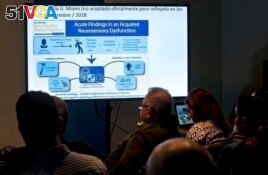The United States government is facing new pressure to solve a mystery: Are American diplomats and officials being attacked with microwaves or radio waves?
The attack has been called the “Havana Syndrome,” because the first cases affected officials in 2016 at the U.S. Embassy in Cuba.
People who are believed to be affected have reported pain in the head, losing balance and signs related to concussions. Some have needed months of medical treatment. Others have reported hearing a loud noise before experiencing the syndrome.
A U.S. defense official said there are at least 130 cases across the government now under an investigation. The National Security Council is leading the investigation.
Especially worrying are the discoveries of at least two possible incidents around Washington, D.C. One happened near the White House last November.
As the number of cases grows, U.S. lawmakers and the people who may have been affected want answers. But scientists and government officials do not know who might be responsible, or even if the incidents were actually attacks.
An official review by the U.S. government could have far-reaching impacts. If a U.S. enemy has been carrying out damaging attacks against U.S. officials, there would be calls for a serious counter-measure.
For now, the Biden administration says it takes the problem seriously and is making sure those affected have good medical care. A bill introduced in both houses of Congress recently would raise payments for injuries suffered in the incidents.
Mark Zaid is a lawyer representing several people who have experienced the syndromes. He and other critics say the U.S. government has not taken the problem seriously or provided those impacted with necessary medical support.
Zaid received National Security Agency documents with information about attacks dating to the 1990s. The documents note an unknown “hostile country” possibly having a microwave weapon “to weaken, intimidate, or kill an enemy over time.”
“The government has a much better understanding of it than it has let on,” Zaid said.
William Burns is the director of Central Intelligence Agency (CIA). He told Congress that he would make sure the investigation gets “to the bottom of what caused these incidents and who was responsible.” So far, U.S. officials have not identified a possible country.

In this March 14, 2019, file photo, Cuban officials make a presentation on a series of mysterious illnesses suffered by U.S. and Canadian diplomats in Havana during a news conference in Havana, Cuba. (AP Photo/Ramon Espinosa, File)
A study looking at causes of the attacks was published last December by the National Academy of Sciences. The study identifies “directed, pulsed radio frequency energy” as the most probable cause. It says a radio frequency attack could change brain activity without causing severe “structural damage.” But the study could not make a certain judgment on how U.S. officials may have been hit.
James Giordano is a neurology professor at Georgetown University. He has worked with the State Department on investigating the Havana cases. Giordano said there is evidence of brain injuries in several people, suggesting they may have been affected by radio waves.
He identified two possible sources. One is a device used to directly target people. Another is a tool that used energy waves for intelligence gathering. That tool may have accidentally harmed the targeted people. Giordano said the attack outside the White House was very similar to the Havana cases.
Other scientists disagree with the findings.
Robert Baloh is a doctor from the University of California, Los Angeles. He argued that any possible weapon would be too large or require too much power to be used secretly.
Baloh said the growing number of cases considered energy attacks is actually linked to “mass psychogenic illness.” A psychogenic illness is when people learn of others in their group with an illness and begin to feel sick themselves.
“Many people are hearing about it and that’s how it gets” spread, Baloh said.
Marc Polymeropoulos is a former CIA officer, who suffered a brain injury in Russia in 2017. He believes the U.S. will find the cause of the incidents and who is responsible.
If the U.S. finds a country responsible, Polymeropoulos said, “there’s going to be uncomfortable decisions on what to do.”
I’m Jill Robbins.
Nomaan Merchant, Robert Burns and Eric Tucker reported this story for the Associated Press. Dan Novak adapted it for VOA Learning English. Hai Do was the editor.
_____________________________________________________________
Words in This Story
microwave — n. a very short wave of electromagnetic energy
syndrome — n. a disease or disorder that involves a particular group of signs and symptoms
concussion — n. an injury to the brain that is caused by something hitting the head very hard
intimidate — v. to make (someone) afraid
pulse — n. a brief increase in an amount of electricity, light, or sound
frequency — n. the number of times that something (such as a sound wave or radio wave) is repeated in a period of time (such as a second)
neurology— n. the scientific study of the nervous system and the diseases that affect it
uncomfortable —adj. causing a feeling of physical discomfort